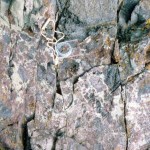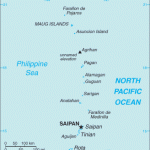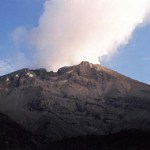Undersea volcanism
Continuing my series where I try to define words of volcanic interest, the new Eruptions Word of the Day is a favorite of mine, mostly because my undergraduate thesis on Vinalhaven Island in Maine ended up dealing with a lot of these types of deposits ... so, without further ado, the word is peperite!
Now, what exactly is a "peperite"?
Well, a picture is worth 1,000 words, right (so that will save me some time):
Peperite in the Vinalhaven Diabase, Vinalhaven Island, Maine. Image by Erik Klemetti. Click on the image to see a larger version.
Let's make some observations:
The rock is full of…
Lots of little pieces of news I've run across ... time to play a little catch up.
Stromboli: A volcano after Don Ho's heart.
Every once in a while, my RSS feeds will dredge up some articles from years gone by ... and this week there were two New York Times pieces that are a few years old, but interesting nevertheless. The first is about research conducted by Dr. Robert Sohn at WHOI on explosive undersea eruptions. The second is work by Corr and Vaughan about finding subglacial volcanism in Antarctica. Both are interesting reads if you missed them (like I did) the first time around.…
Our tour of the Marianas begins SW of Guam. In this area the volcanoes are submerged and make up a region known as the Southern Seamount Province. Our first stop is Tracey Seamount, which lies 30 km west of Guam. Tracey is a ~2 km tall cone and volume of ~45 km3 It is one of the smaller volcanoes in the Mariana arc; Pagan, contains about 2200 km3 of material (Bloomer et al., 1989). It has a sector collapse on its western flank and resembles a submarine Mt. St. Helens. It was investigated by the ROV Hyper-Dolphin from the R/V Natsushima in Feb. 2009, which revealed that the cone is map up of…
The level of news-frenzy on some of the recent volcanic eruptions has died down, but if you're looking to see information on the many rumbling going on worldwide, look no further. Here is this week's Volcanic Activity Report put together by Sally Kuhn Sennert of the Global Volcanism Program.
Highlights - not including Pacaya, Yasur, Tungurahua and our friend in Iceland - include:
The eruption in the Marianas apparently came from South Sarigan volcano - at least according to the best guess by folks who work in the Marianas. This submarine volcano apparently shows evidence of young lava flows…
Quick news on Memorial Day (in the US at least):
Ash soaked by rain from Tropical Storm Agatha on the roofs of homes in Guatemala after the late May eruption of Pacaya.
Sixteen scientists were evacuated from islands in the northern Marianas due to the eruption of the unnamed submarine volcano south of Sarigan Island. The eruption is continuing to be monitored closely by the USGS and National Weather Service as the plume - which is most steam with minor ash - could disrupt air traffic in/around Saipan. The latest USGS CNMI update:
Seismicity at a single nearby station on Sarigan Island…
Sarigan Island in the northern Mariana Islands. An undersea eruption appears to be underway south of the island.
Thanks to the watchful eye of Eruptions readers, we had an inkling of this eruption the other day, but now we have confirmation that an undersea eruption is underway in the northern Mariana Islands. The exact volcano erupting is unknown, but it appears to be between Anatahan and Sarigan (see below) - both active volcanoes in the Marianas - at a depth of 300 meters. The eruption has been described by the USGS as hot water vapor and an ash plume that might have reached as high as 12…
Hard to believe, but there is other volcano-related news in the world ...
So, with all deference to Eyjafjallajokull, here it is:
Dome collapse on Colima in Mexico, image taken March 30, 2010.
The new Smithsonian/USGS GVP Weekly Volcano Activity Report was issued, with news about increasing signs of activity at Egon in Indonesia, a possible plume at Miyakejima in Japan and more dome growth at Soufriere Hills.
A study on the economic effect of a new Vesuvius eruption was released and the finding show the potential for a staggering $24 billion of economic damage directly related to an…
Map showing the location of submarine volcano Marsili, near the Italian coast. Image from INGV.
The subject of submarine volcanism near Italy has come up before here on Eruptions but now it has made the jump into the worldwide media after some claims made by Enzo Boschi, president of the National Institute of Geophysics and Volcanology (INGV).
The long and short of what I can tell from the articles is that Marsili, a submarine volcano in the Tyrrhenian Sea, could be a threat to create a significant tsunami that would hit Italy (amongst other Mediterranean countries). The volcano lies only…
The Icelandic coast of Reykjanes where the Mid-Atlantic Ridge comes above sea level.
A number of Eruptions readers have noticed that seismicity along the Reykjanes Ridge that runs to the southwest of Iceland onto the island has increased over the last few days. Sure enough, checking the Icelandic Met Office page on seismicity on the island finds a lot of earthquakes on the southwest peninsula that is the manifestation of the Mid-Atlantic Ridge hitting the hotspot-related Icelandic landmass. The interaction between the Iceland plume and the Mid-Atlantic Ridge is complex, with a step in the…
The plume from submarine volcano Fukutoku-Okanoba, erupting in February 2010.
Almost a year after the Hunga Tonga Hunga Ha'apai eruption, where an undersea volcano sprang forth from the deep - quite spectacularly, we have new footage of another undersea eruption. Fukutoku-Okanoba, off the coast of Minami Iwo, started to erupt yesterday (or, at least, erupt enough to manifest a plume out of the ocean). A Japanese coast guard vessel was able to capture the plume on video as it reached 100 m / ~300 feet. The plume appears to be dominated by white steam along with some grey ash mixed in.…
Here it is, my attempt to recap a year's worth of volcanic events. By no means is this supposed to capture every event, but rather the highlight/lowlights and what most captivated me during 2009. I'll be announcing the winner of the 2009 Pliny for Volcanic Event of the Year tomorrow.
Waimangu Geothermal Valley in New Zealand, taken in January 2009 by Erik Klemetti.
January
The year started out with a trip to New Zealand (well, for me at least) and vistas of the Waimangu Valley, formed in the 1886 eruption of Tarawera on the North Island. We were also still thinking about the late 2008…
Finals day for me, so I'll be grading grading grading ... but first, a little news:
The May 2009 eruption of West Mata. Image courtesy of NSF and NOAA.
I covered it in May, but the popular press is now all over the West Mata undersea eruption - mostly thanks to the media boost that AGU can give you. It is worth checking out the new articles on the eruption in the Lau Basin near the Marianas, mostly because of the nifty video of the eruption. In the video, you can clearly see both an explosive component of the eruption as gas "burps" out through a cooled carapace and a more effusive pillow…
There have been a number of articles floating around the popular press for the last week that I thought I would touch on briefly ... always fun to decipher the real news from the hype.
Active fumaroles on Datun Mountain in Taipei.
An article out of the Taipei Times suggests that the city of Taipei in Taiwan is in great peril from Datun Mountain/volcano. The volcano, which was previously thought to have erupted ~200,000 years ago is now thought to have erupted only 5,000 years ago. That 195,000 years really does make a difference in terms of worrying about potential future eruptions, but…
I haven't done too many interviews in my day, so this was kind of fun. Wander on over to The Reef Tank and you can read my interview - mostly about the role of water in its many forms on Earth in understanding magmatism and volcanism. Thanks to Ava from The Reef Blog for the interview!
And if you run a blog or website and want to interview me, feel free to drop me a line:
I won't try to recap all the news from last week, but I did notice a few articles from this weekend worth noting:
The Big Obsidian Flow at Newberry Volcano. This rhyolite lava flow erupted at ~1,300 years ago.
Geologists in Greece are keeping an eye on a submarine volcano called Columbus. Apparently a number of M4+ earthquakes have been reported, the sea floor has deformed and there have been "hot air eruption" (? ... I am a little skeptical of the last one without more details). The article is a little fuzzy on the details: the volcano is 6.5 meters southeast of Santorini and the Santorini…
Here's some news bits for all you volcanophiles. Enjoy the weekend!
Ubinas in Peru steaming away in June 2007. Image courtesy of Eruptions reader Mike Lyvers.
There has been a lot of press lately on the theory that a large eruption from an ancient volcanic field in China (the 260-million-year-old Emeishan volcanic province of southwest China) could be the culprit in the grand Permian extinction. I have to admit, I've only skimmed the surface of this study, but the work lead by Dr. Paul Wignall (a paleontologist, not a volcanologist - not that there is anything wrong with that) seems to…
A week's worth of volcano news in one sitting, thanks to the USGS and Smithsonian Inst.'s Global Volcanism Program.
Thanks again, Sally Kuhn Sennert for putting it together!
This week's highlights include:
Small ash column spotted at Manam, Papua New Guinea. We talked about Manam not too long ago.
More details of the ongoing submarine eruption at West Mata in the Mariana Islands.
The lava dome continues to grow on Redoubt, Alaska with no real collapse yet.
Pilots spotted small (2.1 km / 7,000 foot) steam/ash plumes at Suwanosejima, Japan.
5-6 km / 18-25,000 foot ash plumes were produced by…
Things are busy - both volcanically and personally - so I'm going to just give you some links to a bunch of exciting/interesting/insane news:
West Mata erupting on May 5, 2009 in the Lau Basin.
According to a bunch of news sources, the eruption at Fernandina in the Galapagos is over (in spanish). That being said, the PNG noted that there is still a lot of carbon dioxide and sulfur dioxide being emitted, suggesting there is still a lot of degassing magma beneath the vents - at what depth (and will it erupt) is the question.
There is a lot of speculation that Nyiragongo (DRC) is erupting or…
Some brief tidbits from the volcanic realms:
Active volcanism at NW Rota-1
Kilauea? Explosive? You might think of Kilauea as a volcano that generates impressive Hawaiian-style eruptions with fire fountains reaching 100s m and dazzling lava flows, but Don Swanson at HVO sees evidence of a big explosive event at Kilauea. This eruption was ~1,000-1,600 years ago and may have produced a plinian-scale eruptive column and threw cm-scale chunks up to 17 km from the vent.
The intermingling of life and active volcanism always seems counterintuitive, but when you're talking undersea volcanism, all…
Has a week gone by already? It is time for another USGS/Smithsonian GVP Weekly Volcano Activity Report.
Highlights (beyond Fernandina, Pagan and Redoubt) include:
A new underwater eruption at NW-Rota 1 in the Mariana Islands.
Increasing seismicity and incandescence from the rhyolite domes forming at Chaiten, Chile.
A spike in sulfur dioxide emissions from Kilauea, Hawai'i to 700 tonnes/day (up from a 2003-07 average of 150 tonnes/day).
4.5-7.5 km / 15-26,000 foot ash columns produced at Shiveluch in Kamchatka from new lava dome.
Continued dome growth and ~6 km / 26,000 foot ash columns from…


